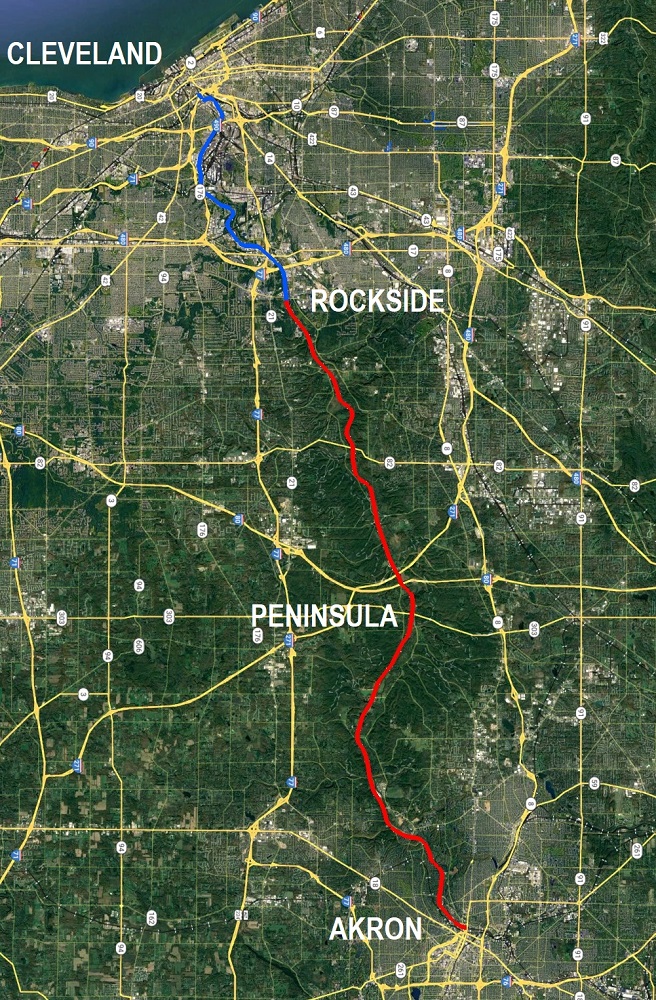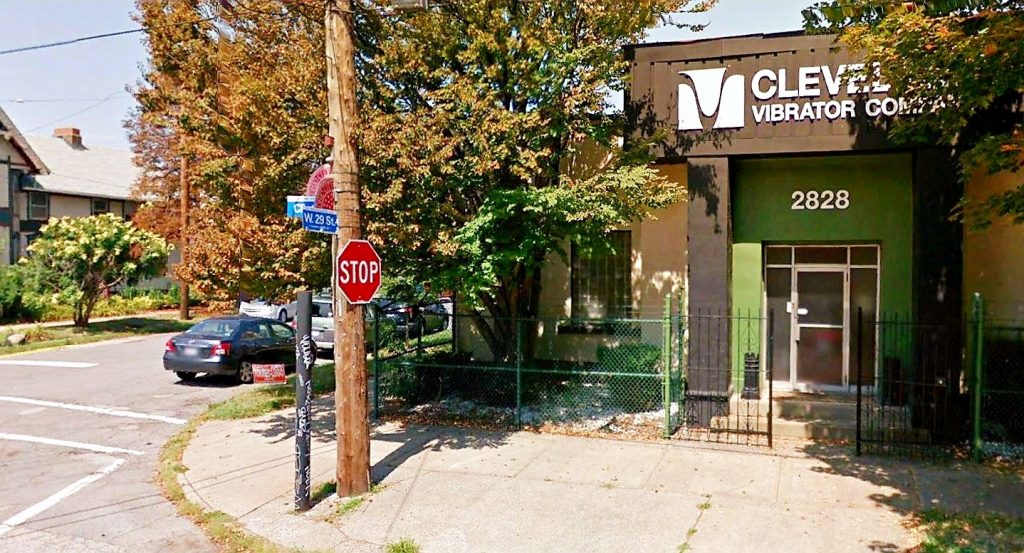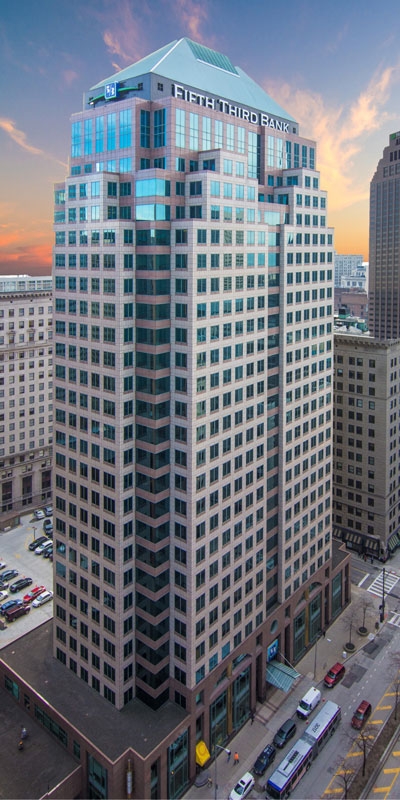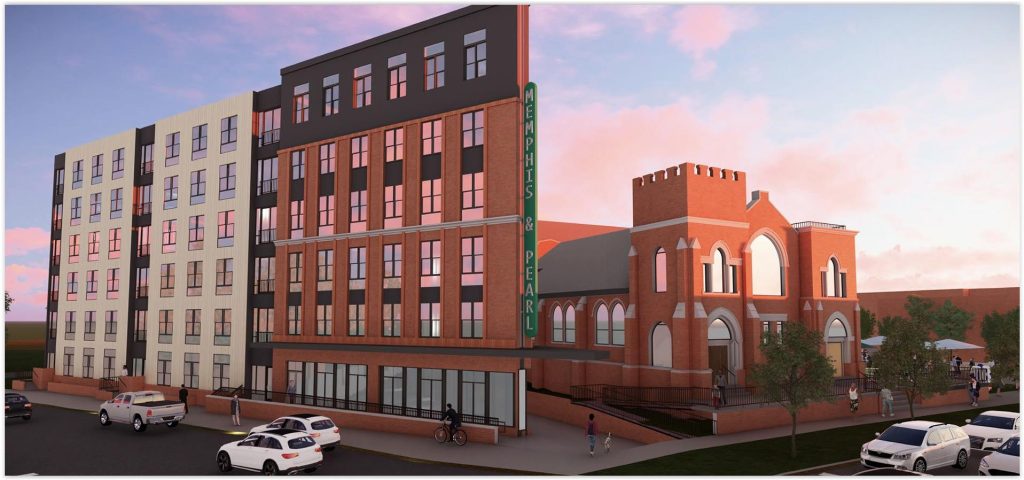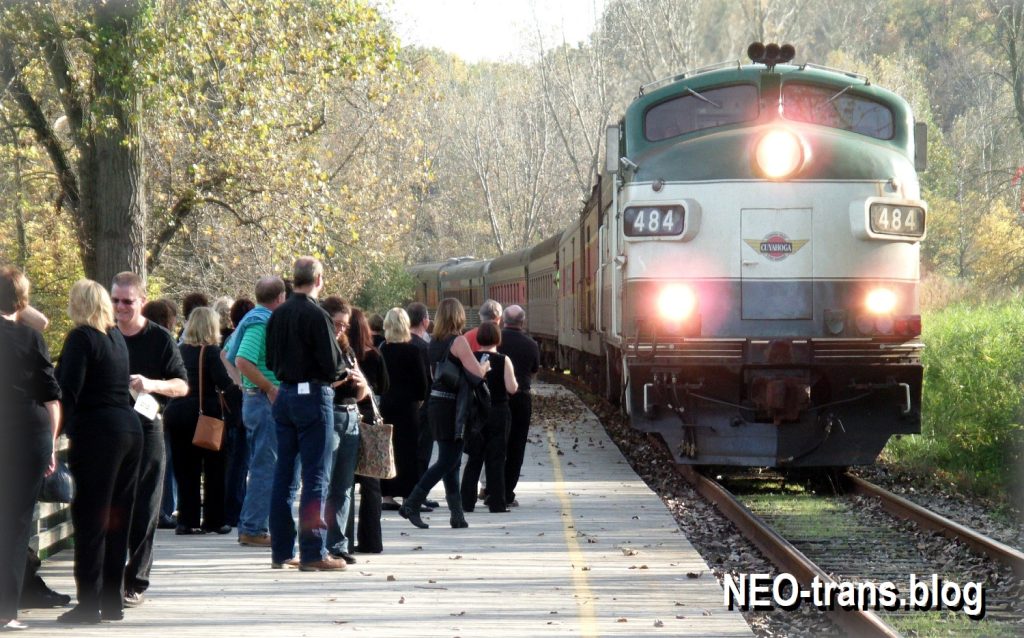
A regional transportation planning organization today voted to hire a consultant to conduct a study of extending the Cuyahoga Valley Scenic Railroad north about 10 miles from Rockside Road, shown here, in suburban Independence to downtown Cleveland. The study will take about a year to complete (KJP). CLICK IMAGES TO ENLARGE THEM.
NOACA hires AECOM to develop cost, benefits data

While it’s only 10 miles from the northern terminus of the Cuyahoga Valley Scenic Railroad (CVSR) in suburban Independence to Downtown Cleveland, it will take years to get there in the best of circumstances. But that first step in the long journey was taken today when a metropolitan transportation planning organization voted to hire a consultant to conduct a feasibility study of the potential route extension.
At its regular meeting, the Northeast Ohio Areawide Coordinating Agency’s board awarded a contract to international engineering firm AECOM, which has offices in Downtown Cleveland and Akron. AECOM will be paid up to $450,000 to conduct a year-long feasibility and engineering study of extending the 24-mile CVSR service north over existing but lightly used railroad tracks that belong to the large freight railroad company CSX Transportation Inc.
The tracks south of CVSR’s northernmost station at Rockside Road belong to the National Park Service (NPS) and continue through the Cuyahoga Valley National Park to Akron’s Northside Station. NPS and CVSR want to expand train service to and from Cleveland to give more people, including students, the poor, the elderly, plus national and international visitors improved access to the park.
NPS contracts with CVSR to provide train service. It complements the parallel Ohio & Erie Canal Towpath Trail that was extended north to downtown in 2020. The railroad service would run along or near the Ohio and Erie Canalway which the U.S. Congress designated as one of just 49 National Heritage Areas to preserve and share important aspects of America’s heritage.
“In talking to people, there’s not a soul who thought it (the downtown extension) was a bad idea,” said CVSR President and CEO Joe Mazur in a phone interview with NEOtrans. “I think it makes all the sense in the world. Between the park’s interest and the community’s interest, I think that providing service on the original valley railway will follow through on the ultimate goal of the national park when it was created which is to connect the park to the people. With the Towpath Trail getting extended into Cleveland, it’s just natural for the railroad to look at it. The feasibility study will tell us if it makes sense to do it.”
He noted the Cleveland extension was studied several times in the past. One of the most recent times was in the late 1990s when a study showed CVSR could attract from Cleveland an additional 100,000 riders per year. When operating normally between Rockside and Akron without a pandemic or hillside erosion interrupting service, CVSR carries about 200,000 riders annually making it one of the most heavily used tourist railroads in the USA. CVSR is currently limited to Akron-Peninsula service due to erosion north of Brecksville and is awaiting hillside repairs.
That now-outdated study also showed it would cost about $20 million to buy the track from CSX, make track and signal improvements and provide stations. Two stops were planned — one at Harvard Road near Steelyard Commons and the last, below Tower City Center in Downtown Cleveland. Persons familiar with the railroad who spoke to NEOtrans on the condition of anonymity said CSX was ready to divest itself of the valley railroad but reneged after it and competitor Norfolk Southern acquired Conrail Corp. in 1999 and split its assets roughly evenly between them.
It remains to be seen if Tower City Center can still be served by an extension of CVSR or if CSX would reconsider selling its tracks. In fact, today’s vote was moved up from March so that it could be completed before Tower City property owner Bedrock Development and the city of Cleveland begin making planned infrastructure improvements and constructing buildings associated with Bedrock’s first phase of riverfront redevelopment.
“We just need to work together on schedules that are aligned,” NOACA Executive Director Grace Gallucci told NEOtrans in an e-mail. At today’s meeting, she also noted that future train service between downtown and Independence might be used by commuters as well as for recreation and access to the Cuyahoga Valley National Park immediately south of CVSR’s Rockside station.
As part of its work, AECOM will update project engineering, estimate capital, operating and maintenance costs, prepare an environmental screening report, assess market reach for potential future ridership, conduct a regional economic impact analysis, conduct a cost/benefit analysis and develop a financial analysis and funding plan, according to NOACA.
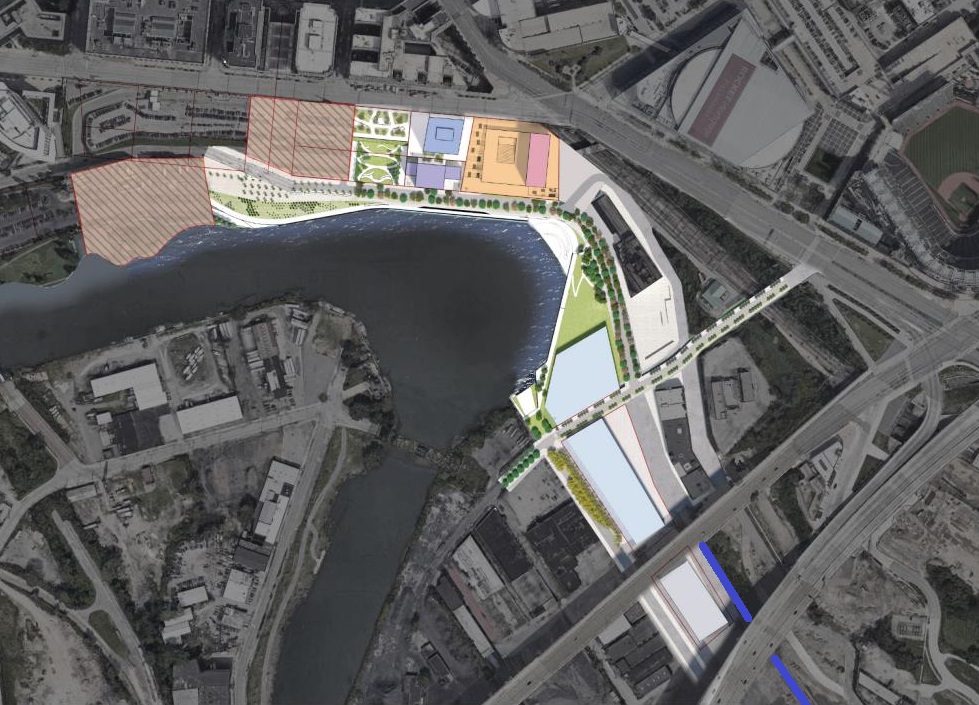
Map of Bedrock Real Estate’s first phases of riverfront development. The blue line shows the remaining track of the potential Cuyahoga Valley Scenic Railroad route that Bedrock does not plan to remove. That blue line ends below the Lorain-Carnegie Hope Memorial Bridge. North of there, structures proposed by Bedrock and a rerouted and elevated Canal Road are planned to be constructed on the former railroad (Adjaye Associates).
“While this procurement item was originally slated for board consideration at its March 2024 meeting, we have moved up the approval process in order to keep pace with city of Cleveland and Bedrock Development’s design plans for redevelopment of a portion of the Cuyahoga riverfront,” NOACA staff wrote in briefing documents for the board meeting today. “This riverfront area surrounds the northern terminus of the proposed CVSR extension.”
Detroit-based Bedrock owns significant portions of Tower City Center which was the former Cleveland Union Terminal railroad station complex, as well as most of the riverside land downhill from it. The first phase of Bedrock’s riverfront development includes a Cleveland Clinic Global Peak Performance Center along with a Cleveland Cavaliers’ basketball practice facility. And it may be slightly larger than what was originally reported, according to sources familiar with the project.
The sports health and practice facility could measure as much as 350,000 square feet and cover the railroad right of way south of Stone’s Levee Road. That road will be rebuilt into a ramping bridge up to Ontario Street similar to but steeper than the old Eagle Avenue ramp that stood here until 2005, city and Bedrock plans show. North of Stone’s Levee Road, Canal Road will be rerouted on the former railroad right of way on an alignment raised 17 feet at the Eagle intersection to reduce the slope of the new Eagle ramp.
Agencies partnering on the project include NOACA, Canalway Partners, city of Cleveland, Cleveland Metroparks, Cuyahoga County, CVSR, Greater Cleveland Regional Transit Authority (GCRTA), Cleveland-Cuyahoga County Port Authority and the National Park Service. For this project, AECOM will be partnering with subconsultants Cambridge Systematics, Inc. on the economic impact and cost/benefit analysis components, with Visibility Marketing Inc. on the stakeholder engagement and research components plus BCC Transportation LLC for track assessment services.
GCRTA owns current and former rail rights of way into Tower City Center, the main station for its three-route, 33-mile rail transit system. Nonprofit advocacy groups like All Aboard Ohio and the Lakeshore Rail Alliance have urged the city, GCRTA, NOACA, Amtrak and CVSR to consider restoring passenger trains service into Tower City. They hoped the NOACA-AECOM study could find a way to achieve that. But they also noted that Bedrock has not yet responded to its meeting requests.

A pair of self-propelled rail diesel cars, typically for carrying commuters, traveled on the Baltimore & Ohio tracks between Akron and Cleveland. Normally B&O trains operated into Cleveland Union Terminal seen towering in the background beyond Sherwin-Williams’ Canal Road buildings. This train, however, was for a special trip between Cleveland and Akron on April 23, 1961 (JWR).
Lora Brand, vice president of communications at Bedrock, did not respond to e-mails from NEOtrans seeking comment for this article. City officials who spoke off the record with NEOtrans said they supported the CVSR extension as long as it didn’t compromise any part of Bedrock’s proposed development. CVSR’s Mazur said he has met with Bedrock and had good conversations with them.
“They (Bedrock) understand the value of the train,” he said. “But the sooner we get the answers (from the study) the better because they are moving forward (with riverfront development). We’re lucky to have Bedrock and (owner Dan) Gilbert dropping that kind of money on Cleveland’s riverfront. We don’t want to miss the opportunity to take advantage of that.”
In a controversial move last spring, city officials removed a lien the city of Cleveland had on the railroad right of way south to a railroad lift bridge over the Cuyahoga River, below Interstate 490. Removal of the lien was done to enable the sale of that portion of the railroad to Bedrock. But it was done without approval by the city’s Board of Control or City Council.
That lien included an ownership reversion clause if the railroad’s owner, in this case CSX, stopped using the tracks. That portion of the tracks was built on the Ohio & Erie Canal in the late 1870s and was owned by the city until it sold the right of way in 1980 to raise cash after going into default on its loans in the late 1970s.
CSX stopped using that portion of its railroad when its last customer north of Interstate 490, Cleveland Thermal, closed its coal-fired Canal Road plant in 2017. It meant the city could have recovered its ownership without condition — including not having to pay for it. Instead the city relinquished its lien on the railroad right of way after CSX stopped using it.

Article from 1978 on the city’s sale of the Cuyahoga Valley railroad right of way to Chessie System which later became part of CSX Transportation Inc. The sale included a reversion clause which would automatically return ownership of the railroad property to the city if the railroad stopped using it (PD).
“Giving away railroad property without getting something in return especially impacts Ward 12 since the updated report on the failing railroad bridges had a number of them from Slavic Village in the top-10 worst,” said former Ward 12 Councilman Anthony Brancatelli who supported Canalway Corridor initiatives during his 17 years on City Council.
Bibb administration and city council officials either did not respond to NEOtrans’ e-mails seeking comment or otherwise declined to comment on the lien removal.
Not only is CSX not using the track north of Interstate 490, CSX has piled gravel onto its tracks on either side of its lift bridge below the highway to prevent any train switching maneuvers from getting close to its bridge. Using a different route to the southwest, CSX handles traffic to/from steel mill-associated short line railroads at its Clark Avenue Yard.
CSX has only two freight customers on its valley railroad south of the Clark Avenue Yard to Independence, called the Willow Industrial Track, the railroad sources said. They said CSX is often unsupportive of most passenger rail expansions involving its tracks unless there is strong community financial support for the expansion. The NOACA action today includes an authorization for up to $25,000 to engage CSX in public project services.
They also said the study should help open a dialogue on the Cleveland extension and preserve rail freight service to its customers, including possibly selling the tracks to a short-line railroad or to a public entity such as the Port of Cleveland. William Friedman, president and CEO at the Cleveland-Cuyahoga County Port Authority, told NEOtrans his organization has not considered such discussions.
END

